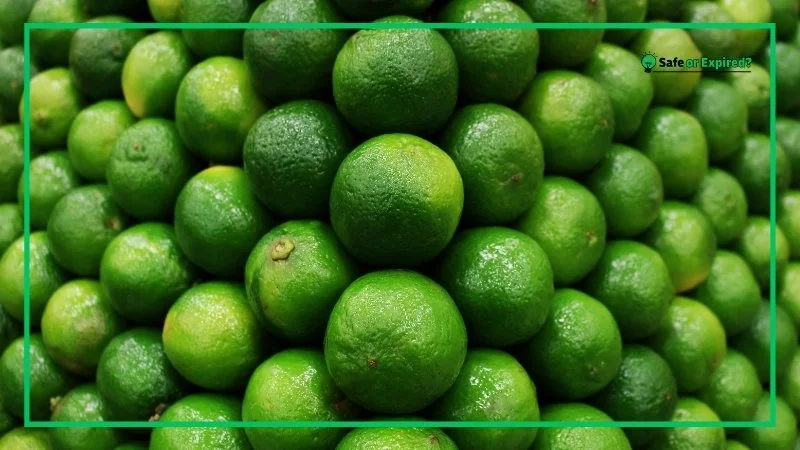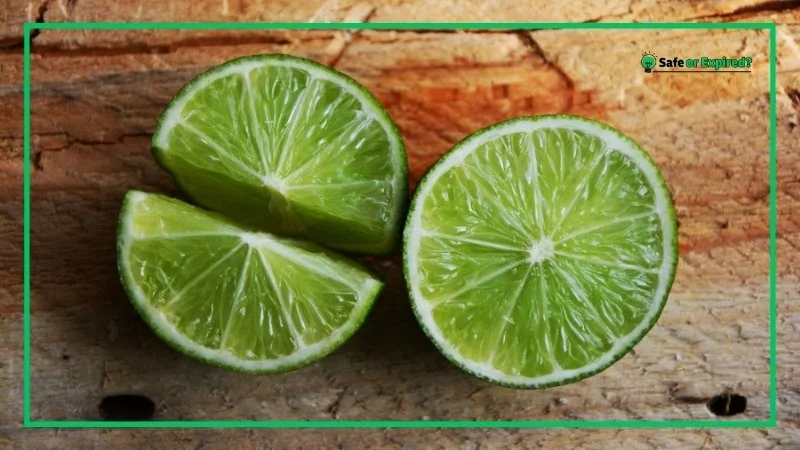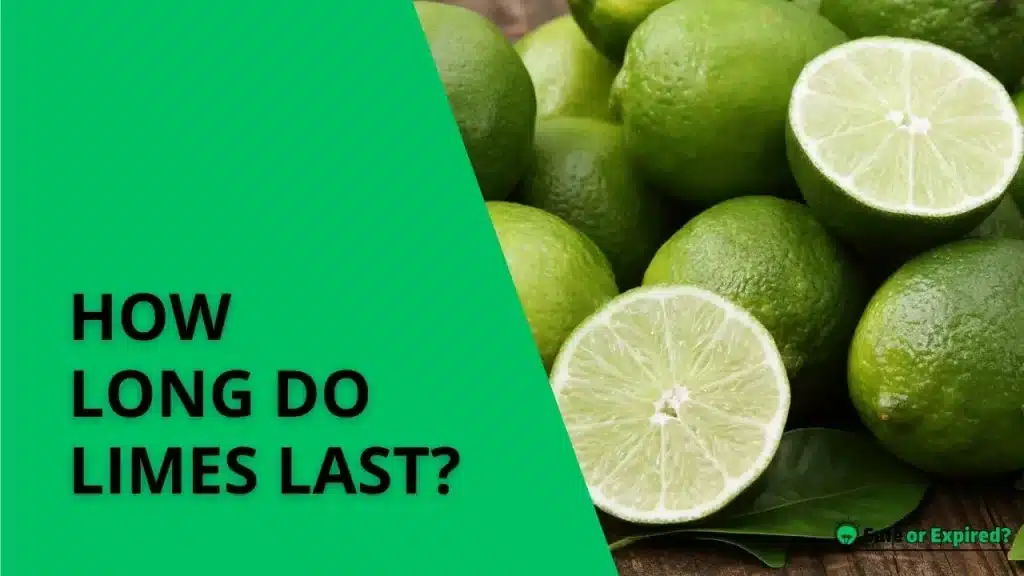Ever wondered, “How long do limes last?” Well, it depends on storage conditions, but generally, they can stay good for a week. But the thing is – keeping limes fresh is key. From fridge tips to room temperature tricks, this article has everything you need. Stick around to uncover the top secrets to prolonging lime freshness like a pro!
How Long Do Limes Last? All the Critical Details
Limes typically last about one week if kept at room temperature and up to four weeks in the refrigerator. For longer preservation, limes can be frozen, extending their freshness for up to six months. Proper storage involves keeping them in a dry place or securely wrapped in a refrigerator’s crisper drawer.
How Long Do Limes Last at Room Temperature?
Limes stay fresh for approximately one week when stored at room temperature. To extend their life, keep them away from direct sunlight in a well-ventilated area. Their shelf life at room temperature depends significantly on the humidity and temperature of the environment.

How Long Do Limes Last in the Fridge?
When stored in the refrigerator, limes can last from three to four weeks. Place them in a plastic bag with perforations to allow for air circulation, which helps maintain their texture and moisture, thereby extending their shelf life effectively.
People also ask, “How long does lime juice last in the fridge?” Freshly squeezed lime juice stored in the refrigerator remains good for up to four days. Keep it in an airtight glass container to preserve its freshness.
How Long Do Limes Last in the Freezer?
Frozen limes can be kept for four to six months without losing much of their quality. For best results, wash and dry the limes, then slice or segment them before freezing in a single layer on a baking sheet. Once solid, it’s recommended to transfer them to a freezer-safe bag or container.
How Long Do Limes Last in Water?
Limes can last up to two weeks when submerged in water, significantly extending their freshness compared to dry storage. Keep the container in the refrigerator and change the water every few days to maximize the limes’ lifespan.
These are the factors affecting the shelf life of limes in water:
- Temperature: Limes last longer in cooler temperatures, so refrigerated water is ideal.
- Water Freshness: Regularly changing the water in which limes are submerged prevents bacterial growth and decay.
- Lime Condition: Fresh, unbruised limes without cuts will last longer in water. Bruises and cuts can accelerate spoilage.
- Container Cleanliness: The cleanliness of the container holding the limes and water also impacts shelf life. A clean, airtight container reduces exposure to contaminants.
- Light Exposure: Keeping limes in a dark place or an opaque container can further extend their shelf life by slowing down the degradation processes caused by light.
How Long Do Limes Last Once Cut?
Once cut, limes typically last between 3 to 5 days (only if you store them appropriately). To maximize their freshness, place the cut limes in an airtight container. If you can’t, then at least keep them away from direct sun rays.

If you want, you can also wrap them tightly in plastic wrap or aluminum foil. This prevents them from drying out and absorbing odors from other foods in the fridge. It’s also advisable to store them in the crisper drawer, where the environment is more humid, helping to maintain their moisture levels.
How Long Do Dehydrated Limes Last For?
Dehydrated limes can last for up to 2 years if stored properly. To ensure maximum shelf life, keep them in a cool place in an airtight container. Moisture and light are the main enemies of dehydrated fruits, so storing them in a dark, moisture-free environment will help preserve their flavor and prevent spoilage.
How Long Do Limes Last on the Tree?
Limes can remain on the tree for several weeks after they mature. However, the best quality is maintained if they are picked when they turn a light green color. Limes left on the tree too long may eventually lose their juiciness and become dry as they overripe, but they can still be quite usable if they don’t show signs of decay or disease.
Here’s a table summarizing the shelf life of limes under various conditions:
| Condition/Situation | Shelf Life |
| Room Temperature | Up to 7 days |
| Refrigerated | Up to 4 weeks |
| Frozen | Up to 4-6 months |
| In Water (Refrigerated) | Up to 2 weeks |
| Once Cut (Refrigerated) | 3-5 days |
| Dehydrated | Up to 2 years |
| On the Tree | Several weeks |
How Long Does Liquid Lime Last?
Liquid lime, often used as a soil amendment, typically has a shelf life of up to two years when stored properly. It should be kept in a sealed container and stored in a cool place to prevent degradation.
Once opened, it’s important to reseal the container tightly to protect it from moisture and contamination, which can reduce its effectiveness and lifespan.
How Can You Tell When Limes Go Bad? Top Signs
You can tell limes are bad when they exhibit signs of discoloration, develop a mushy texture, or give off an unpleasant odor. Limes that have dried out or show visible mold spots should also be discarded to avoid consuming spoiled produce.
Discoloration
When limes start turning yellow or brown, it’s a clear indication they are past their prime. The vibrant green color fades as the limes age and as they get exposed to air or too much light. Discoloration often starts at the ends or where the skin is most exposed and can spread if the lime is left unused. While a slightly yellow lime might still be usable, brown spots are a tell-tale sign of spoilage, and it’s best to throw these limes away.
Mushy Texture
A fresh lime should feel firm to the touch. If you notice that the lime has become soft or mushy, it’s likely going bad. This change in texture indicates that the internal structure of the lime is breaking down, either due to overripeness or an internal infection.
A mushy lime may also leak juice involuntarily, which can attract insects or lead to mold growth if left unchecked.
Unpleasant Odor
Limes should have a fresh, citrusy smell. An off-putting odor is a sign that the lime has started to ferment or rot. This could smell sour, like vinegar, or have a musty, mildew-like scent. Any lime that smells different from its usual fresh citrus aroma should be discarded to avoid the risk of consuming spoiled or contaminated fruit.
Dryness
Limes typically contain a considerable amount of juice. If you cut into a lime and find it dry or nearly juiceless, it’s a sign that the lime is old or has been stored improperly. Dry limes won’t provide the zest or juice you expect and are best used for decorative purposes or discarded.
Many outdated or incorrect beliefs about food preservation can lead to spoilage. For accurate information, read “Busting Myths About Food Preservation.”
Mold Growth
Visible mold on the exterior or interior of a lime is a definitive sign that the lime has gone bad. Mold may appear as fuzzy spots that can be white, green, or black. Consuming moldy limes can be harmful to your health, so it’s important to discard any limes showing signs of mold immediately.
Always check parts that are out of sight, like the area around the stem or the base of the lime, as mold can start there and spread.
How to Keep Limes Fresh for a Long Time?
To keep limes fresh for a long period, you should store them in your refrigerator’s crisper drawer in a breathable plastic bag. This method can extend their freshness up to a month. For longer storage, consider freezing the limes or their juice.
Refrigerate Properly
Storing limes in the refrigerator is one of the best ways to extend their shelf life. But how to store limes in fridge? Ideally, place them in the crisper drawer, which is designed to maintain an optimal humidity level for fruits and vegetables.
Use a mesh bag or a perforated plastic bag to allow air circulation, which prevents moisture accumulation and mold growth. Refrigeration can keep limes fresh for about three to four weeks.
Use a Sealed Container
If you’ve already cut your limes and want to save the rest, store them in an airtight container/plastic bag before placing them in the fridge. This prevents the limes from absorbing the odors of other foods and maintains their moisture, keeping them juicy and fresh. This method can keep cut limes fresh for about three to five days.
Keep Limes Dry
Before storing limes, ensure they are dry and free from moisture. Wetness can promote mold growth and cause the limes to spoil quickly. If you wash them before storing them, then it’s recommended to dry them thoroughly with a towel. Always handle limes with clean hands to avoid transferring bacteria or other contaminants that might accelerate spoilage.
Avoid Light Exposure
Store limes in a dark place if you’re keeping them at room temperature. Exposure to light can accelerate the ripening process, leading to a quicker deterioration. A pantry, cupboard, or any other dark, cool area in your kitchen can be ideal for short-term storage of up to a week.
Freeze for Long-Term Storage
People often ask, “How to keep limes fresh after cutting?” The answer is freezing. Freezing limes is a great option for long-term preservation. Wash and dry the limes, then cut them into slices or wedges. After this, spread them on a baking sheet, which should be lined with parchment paper. Ensure that they don’t touch each other.
Next, you can freeze until solid. After this, you can transfer the frozen pieces into a ziplock freezer bag. This method can keep limes fresh for several months.
Discover more essential tips in “Guidelines for Effective Food Storage and Preservation.”
Conclusion
Understanding the longevity of limes ensures you always have fresh citrus on hand for your culinary needs. Here’s a summary of their shelf life under various conditions:
- Room Temperature: Limes typically last about a week when stored at room temperature.
- Refrigerated: In the fridge, limes can remain fresh for up to four weeks.
- Frozen: For long-term storage, freezing extends their usability to several months.
Keep this guide in mind to make the most of your limes, ensuring they’re always ready when you need that splash of zest!

